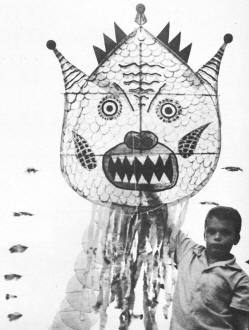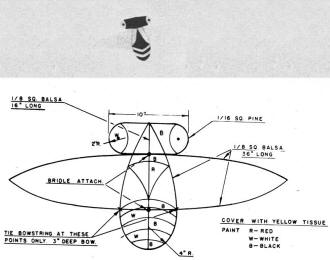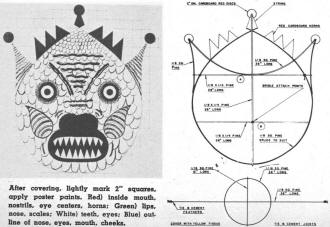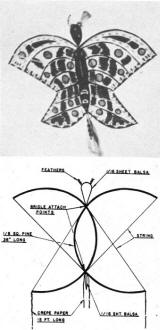|
Living in Erie, Pennsylvania, there are a lot
of days that are too windy for comfortably flying the gliders and 1/2A-sized models I
build. If the weather forecast says the winds are in the double digits, I stay grounded.
Sometime if it has been a couple weeks since winds and/or rain and/or snow has prevented
flying, I'll brave a 12-15 mph wind just to get in some stick time, but the experience
is not particularly enjoyable. It is good practice for maintaining control of your ship
in the event of unexpected gusts, but certainly not the preferred environment. Contest
flyers have to learn to be good in all weather, which is probably part of why I never
competed. This article about building and flying kites in winds too high for flying models
is a good idea. The designs presented by author William Paxton are more sophisticated
than most people would undertake to build. Simple kites are still available at drug stores
and of course
kites with just about any degree of complexity via the Internet.
Me Build a Kite? Quit Ya Kiddin!

Impressive size of Bill Paxton's "Sky Monster" apparent when shown
by author's nine-year-old son. Anybody who can build models will do fine with kites.
sez W.P. Cross members are bowed approximately 4" deep at center posts.
What to do when wind's too strong to fly planes?
Simple, says William H. Paxton, Jr. Pull out a Chinese kite then watch the crowd gather.
Never more will you say ...
Me Build a Kite? Quit Ya Kiddin!
How many of you have ever seen a real honest to goodness Chinese Dragon Kite? Not
many, I'll bet. Neither had my nine year old son. So when he asked what they looked like,
we decided to build an American version of one to show him. The results are shown in
the accompanying photographs and drawings of "Sky Monster." Standard hobby shop materials
are used and construction is really quite simple.
Other kites shown are "one nighters" and drawings or photographs are just about self-explanatory.
Luminous paint may be used on the Bumble Bee kite with startling results if flown in
a mild breeze on a moonlit night. Your imagination may be your guide in coloring the
Butterfly kite or perhaps you could copy the real thing.
Any of these kites will give you and your family hours of enjoyment. If you have a
kite contest scheduled in your area a little initiative and imagination on your part
should make you a sure winner.
As a sort of P.S. to the model airplane builders, I would like to remind you that
the wind which stops you from flying airplanes is not so hard to take if you have a kite
like these to pull out of the back of the car!
You'll really stop traffic with the Dragon head. Here's how it's made:

Bumble Bee Kite
Little "Bumble Bee," a steady hands-off flyer, will soar on slightest
breeze. Tie it to your car's radio antenna to show wind direction when model flying.
Select straight-grained wood which can then be bent into shapes desired by steaming
over a kettle. Tie and cement all joints after making a trial layout of the various members.
Dimensions were purposely left off of the drawing where not necessary as kite construction
can vary considerably without affecting the flying ability. Do try to keep the framework
balanced about the vertical member, however.

After covering. lightly mark 2" squares. apply poster paints. Red)
inside mouth, nostrils, eye centers, horns; Green) lips, nose, scales; White) teeth;
eyes; Blue) outline of nose, eyes, mouth, cheeks.
Cover the head loosely with yellow or orange Silkspan model airplane tissue and paint
the face with poster paints as noted. Cross members "A" and "B" are bowed with heavy
string the same as you would a ten cent variety kite, and for additional strength scrap
wood posts are added at tile center.

Butterfly Kite
No bowing is necessary on the "Butterfly" Kite which can be as varied
in coloring as the rainbow. Get your gal to paint it.
Horns and small discs are cut from cardboard, painted red and cemented in place. Heavy
carpenter's chalk line is used for the bridle which is attached at three points. The
top cords should be about 30" long and the bottom cord about 29" long. That finishes
up the head except for the chin whiskers which are better applied later.
Now let's make 25 tail discs as noted and cover with either Silkspan or Jap tissue.
Red, or any colored feathers attached to the balance arms may be purchased from ladies'
hat shops or ordinary chicken feathers may be dyed to suit with food coloring dyes. (In
my case we just happened to have a bright red feather duster that very mysteriously disappeared
one day!)
Next comes the rigging of the tail discs to the head, and if you can get someone to
help you with this, it will go very much faster than trying to do it alone - that is,
unless you're an octopus. Ordinary kite string is used to attach the discs which are
spaced 12" apart and tied together at top, bottom and sides. Green and yellow crepe paper
streamers approximately 1" wide and from 15 to 25 feet long are cemented to the head
and tail and you're all ready to go flying.
Chalk line or other heavy cord must be used in flying Sky Monster due to the heavy
pull of such a large kite. Before launching, make a check of the bridle to see that it
is centered properly. I would also suggest adding some fairly heavy metal washers to
the bottom of a couple of the longer chin whiskers which can then gradually be removed.
In launching, the head is tilted slightly downward which will cause the tail to rise
if sufficient wind is about. Have someone hold the head in this position and then release
it after 50 to 100 feet of kite cord has been let out. A dive to either side may be corrected
by additional weights added to the whiskers, by adding weights to either side of the
head by re-centering the bridle, or by shortening the lower bridle cord. If the kite
does not climb to suit you, try shortening the top bridle cords.
Posted December 17, 2018
|